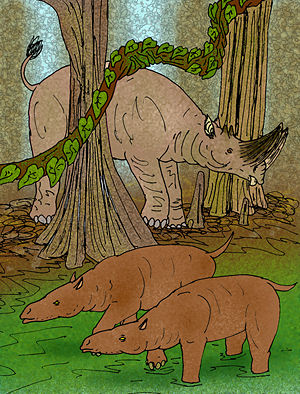- Bothriogenys
-
Dieser Artikel wurde aufgrund von formalen und/oder inhaltlichen Mängeln in der Qualitätssicherung Biologie zur Verbesserung eingetragen. Dies geschieht, um die Qualität der Biologie-Artikel auf ein akzeptables Niveau zu bringen. Bitte hilf mit, diesen Artikel zu verbessern! Artikel, die nicht signifikant verbessert werden, können gegebenenfalls gelöscht werden.
Lies dazu auch die näheren Informationen in den Mindestanforderungen an Biologie-Artikel.
Bothriogenys Zwei Bothriogenys, im Hintergrund ein Arsinoitherium
Zeitraum unteres Oligozän Fundorte Systematik Säugetiere (Mammalia) Paarhufer (Artiodactyla) Anthracotheriidae Bothriodontinae Bothriogenys Wissenschaftlicher Name Bothriogenys Bothriogenys ist eine ausgestorbene Säugetiergattung aus dem Oligozän. Sie ernährte sich ausschließlich herbivor.
Merkmale
Bothriogenys war kleiner als verwandte Arten wie Anthracotherium und erreichte etwa einen Meter Schulterhöhe. Der Körper war dem eines Flusspferds sehr ähnlich, doch die Beine waren im Vergleich etwas länger. Der Kopf war relativ lang und schmal.
Systematik
Bothriogenys war ein Paarhufer. Es sind bisher sechs verschiedene Arten entdeckt bekannt, die alle in und um Ägypten herum gefunden wurden:
- Bothriogenys fraasi, 1913
- Bothriogenys andrewsi, 1913
- Bothriogenys parvus, 1906
- Bothriogenys africanus, 1899
- Bothriogenys rugulosus, 1913
- Bothriogenys gorringei, 1902
Literatur
- Donald R. Prothero, Scott E. Foss (Hrsg.): The Evolution of Artiodactyls. Johns Hopkins University Press, Baltimore MD 2007, ISBN 978-0-8018-8735-2, S. 95.
Kategorien:- Paarhufer
- Artiodactyla
- Ausgestorbenes Säugetier
Wikimedia Foundation.

